Menus
- MV Agusta Brutale 800 and Triumph Street Triple R in comparison test
- MOTORCYCLE scoring / test results
- Technical specifications
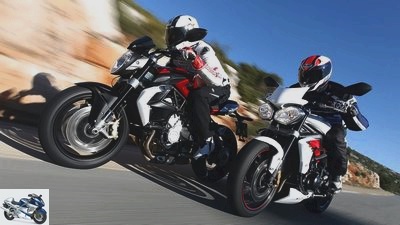
Jahn
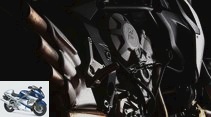
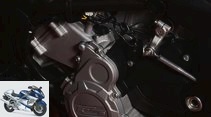
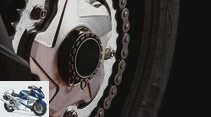
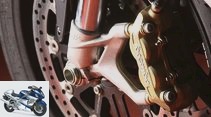
15th photos
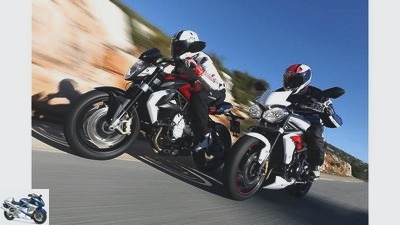
Jahn
1/15
The hot naked bikes: MV Agusta Brutale 800 and Triumph Street Triple R in a comparison test.
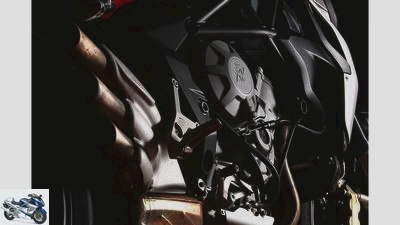
Jahn
2/15
The stainless steel exhaust system is one of the most beguiling that the market has to offer.
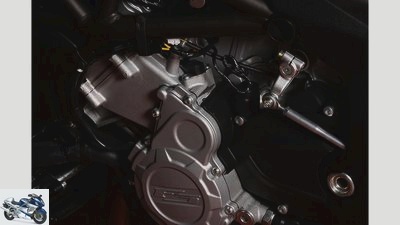
Jahn
3/15
A model of compactness: The dainty MV three-cylinder is not believed to have its 800 cubic centimeters.
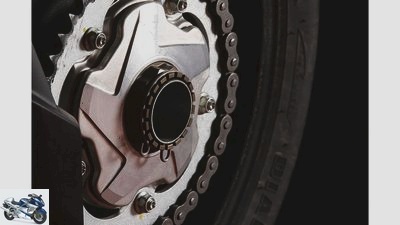
Jahn
4/15
The mighty single-sided swing arm – the Brutale 800 doesn’t show the need to save.
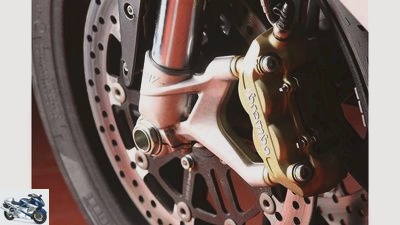
Jahn
5/15
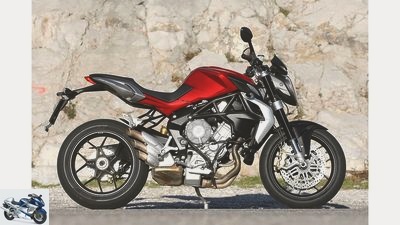
Jahn
6/15
MV Agusta Brutale 800.
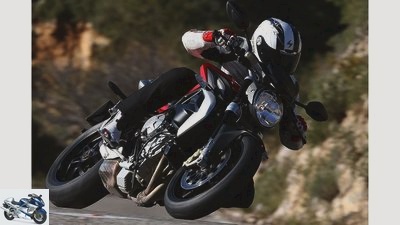
Jahn
7/15
MV Agusta Brutale 800.
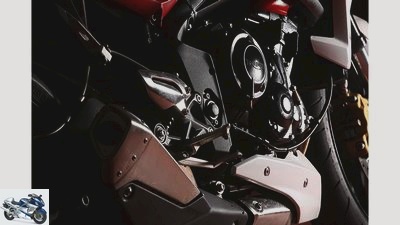
Jahn
8/15
Formally, the silencer cannot compete with that of the MV, the fully adjustable shock absorber is designed to be tighter than before.

Jahn
9/15
Rather expansive: Compared to the MV Triple, the Triumph engine is almost massive.
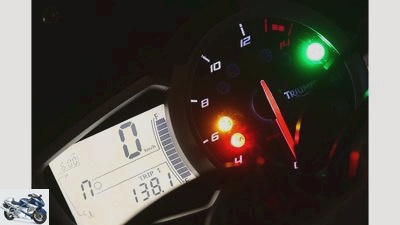
Jahn
10/15
The cockpit is clear.
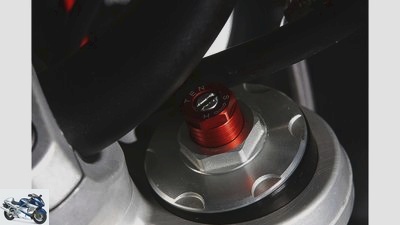
Jahn
11/15
A functional faux pas: the rebound adjustment of the fork is practically inaccessible because of the handlebars.
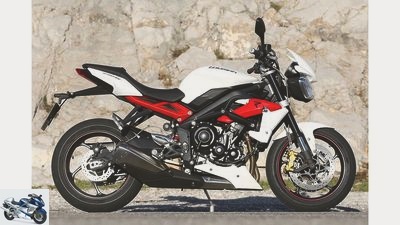
Jahn
12/15
Exalted and balanced: The Street Triple R combines both worlds.
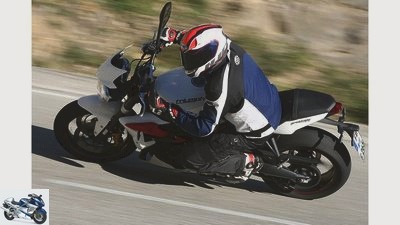
Jahn
13/15
Triumph Street Triple R..
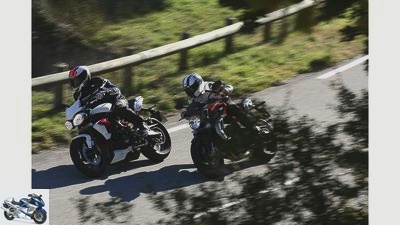
Jahn
14/15
Just don’t let anything burn: the two nakeds tempt you to heat.
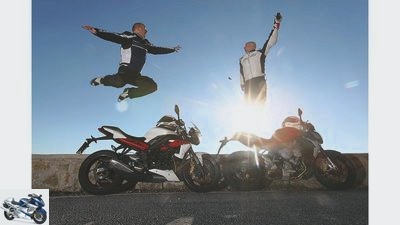
Jahn
15/15
The Triumph Street Triple R entered the race as the favorite and won the group test.
Comparison test: Naked bikes from MV Agusta and Triumph
MV Agusta Brutale 800 and Triumph Street Triple R in comparison test
"Tre Pistoni" – that sounds clearly more dangerous than "Triple" on, but means the same. Now with 800 cubic centimeters, the new Brutale shoots even sharper than the recently renovated Speed Triple R.?
Faster than the police allow – that can be pretty quick. Especially when you let go of power as emphatically and extrovertly on the rear wheel as a three-cylinder. The Brutale’s new 800 triplet saws as inimitable as its little brother in the 675, the three-cylinder of the Street Triple whistles in the best family tradition, as only a Triumph can.
In doing so, considerable mountains of torque make their way over the rear wheel even at manageable speeds and provide a refreshing boost even deep in the speed cellar. And then there is this explosive revving up well into the five-digit range, which ensures that even thoughtful natures get stuck here and there. Of course, also because the British Triples and Italian Tre Pistoni are so radically packaged.
Middle-class naked bikes – this term is clearly too harmless for what the Brutale 800 and Street Triple R offer in terms of looks and dynamics. No, it’s street fighters, real street fighters, who meet here for a shootout. There is hardly anything on public roads that can hold a candle to this fascinating mixture of sensationally low weight (186 kilograms with a full tank of the MV, 188 kilograms for the Triumph) and powerful acceleration.
I.At the forefront of this is recently one that draws faster than its shadow even from the paper form. Brutale 800 – that is nothing less than a new dimension of performance in an environment in which a combative wind is blowing anyway. The triple, which has grown through more stroke alone (now 54.3 millimeters instead of 45.9 millimeters for the Brutale 675), now produces a nominal 125 hp, and on the MOTORRAD test bench there are still 121 cheery horses left. What this cavalry does in combination with the lush torque and a relatively short secondary translation compared to the Street Triple with the petite brutal, imaginative readers can imagine for themselves. For everyone else: there are moments when the ride on a Brutale 800 is like the famous ride on the cannonball. Whenever the triplet gets its second breath from a second-gear corner around the 8000 mark, it puts the compact Brutale on the rear wheel so brilliantly that even hardened pilots gasp for air and cling to the wide tubular handlebars. No wonder, because the displacement cure is particularly effective in the upper engine speed regions. The 800 delivers between ten and just under 20 hp more than the small 675 Tre-Pistoni – and thus puts the three-cylinder from the island, in which everything remained the same except for minor mapping interventions, in every respect.
Buy complete article
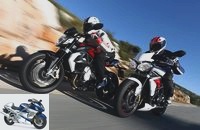
Comparison test: Naked bikes from MV Agusta and Triumph
MV Agusta Brutale 800 and Triumph Street Triple R in comparison test
Like its little sister, the MV Agusta Brutale 800 has a massive problem with the throttle response, but the bottom line is that none of its four different mappings (rain, comfort, normal, sport) provide a well-functioning set-up. The Diva is almost impassable in the “Rain” setting, in which the engine accelerates so slowly and jerkily, as if there was a serious technical defect. The sport version still works best, but here too the following applies: The three-cylinder responds with a delay, but then like an attack and therefore demands the driver’s full attention always and everywhere. Driving the Brutale 800 almost on the side is not possible – and really committed driving the Brutale 800 is always exhausting because the throttle hand has to constantly react to the capers of the engine. Well, where is it, the performance? Keep the gas on! Uuuupps, there she is, with power! So turn on the gas very quickly. And all over again immediately.
Jahn
MV Agusta Brutale 800.
It is understandable that under these conditions even easy cornering turns into hard work. After all: the statement by the MV technicians that they are working feverishly on more finely tuned software with faster control intervals for the throttle valves operated electrically, i.e. by servomotors, shows that there is an awareness of the problem. The problem with this is that this statement has been in place since the three-cylinder engine premiered around a year ago – and nothing decisive has happened.
The exemplary solution of the Triumph (with only one mapping, without traction control and ride-by-wire) shows that, at least in this vehicle class, the conventional way with gas cables between the gas handle and throttle valve can be the best. The triple depends on the accelerator to the point, always and under all circumstances delivers exactly as much power as is currently required – and thus makes even difficult driving maneuvers such as a lustfully performed wheelie a real pleasure, while the curious Italian triple the During this exercise, the driver would like to throw backwards over and over again.
So much for the irrationality that these two bandits constantly challenge. Not only in frequent sprint duels, where both are almost on par at up to 140 km / h because of the strong MV’s latent tendency to wheelie, but also in tough cornering skirmishes. And again: Advantage of triumph, because the Street Triple is in no way as extreme, but more balanced in every respect than the Brutale. This is most noticeable during handling. Of course it is impressive how playfully this MV can be thrown from one corner to the other. In this respect, the Street Triple, the latest version of which has significantly more weight on the front wheel and which has become noticeably more unwieldy, cannot keep up. But the extreme chassis design of the MV with an ultra-short wheelbase (1380 millimeters) and a steep steering head angle (66 degrees) as well as the low weight also shows the limits of the concept. The Brutale 800 is a nervous animal that rewards every twitch of the handlebars with a mighty hook. The bump on every sloping bump gets out of hand and requires steering corrections, but only very rarely draws a clean line. The front and rear, despite the now fully adjustable spring elements, do not deflect synchronously because the fork bounces and dampens comfortably, but the strut distributes rock-hard blows.
Jahn
Triumph Street Triple R..
The bottom line is that in terms of comfort, stability, neutrality and feedback, the Brutale is a long way from the level that a Street Triple R offers. It has become much tighter in the current model year than its predecessor, but in direct comparison it offers a more suitable set-up for everyday use and is worlds ahead of the brutal, especially in terms of feedback and neutrality. Incidentally, the same applies to the braking systems. The Nissin four-piston fixed calipers of the Triumph bite much more powerfully and more easily than the Brembos of the MV, ABS was unfortunately not available for the Street Triple by the editorial deadline (coming in January) and will be submitted for the Brutale in autumn.
Do such rational options make sense with these arsonists? Yes, absolutely, especially since both of them should not only be interesting for adrenaline junkies because of their radical outfits. The MV in particular inspires (even in the muted wine red of the test motorcycle) with a beguiling design language, in view of which some functional deficiencies are likely to take a back seat. Seen in this way, the point defeat of the new Brutale 800 could be a venial sin. Even if the distance is very, very clear.
MOTORCYCLE scoring / test results
Jahn
Just don’t let anything burn: the two nakeds tempt you to heat.
engine
Exemplary pulling power of the MV at Superbike level, but still almost undecided: That shows where the problems of the MV engine are. The response behavior is poor, the smoothness is not exhilarating and the switching paths are long. The Triumph engine, on the other hand, is exemplary on the gas and does not show any other nakedness.
Winner engine: MV Agusta
landing gear
A weak point of the Brutale 800: the unbalanced chassis. Except in terms of handiness, the MV clearly loses points in almost all chapters. Above all, there is a lack of stability and steering behavior, the feedback is modest, the directional stability is poor. The Triumph can do all of this much better. And it’s even more comfortable.
Chassis winner: triumph
everyday life
The old topic: everyday life. It is simply not one of Italy’s established strengths to build motorcycles suitable for everyday use. Whereby it is mainly due to the lack of range that the Brutale ends up so far behind. But 272 kilometers driven extremely cautiously are not enough. And when the going gets tough, the tank is ebb after 150 kilometers.
Winner everyday: triumph
security
Better brakes, less kickback. The advantage of Triumph is reduced to this formula. The tendency for the handlebars to flap on the Brutale 800 with its light-weight front wheel should be taken seriously.
Winner safety: triumph
costs
The MV three-cylinder burns 6.1 liters of super – almost one and a half liters more than the Triumph, whose economy pays off.
Winner Cost: Triumph
Price-performance
With such a large point advantage, the winner in this chapter can only be Street Triple R..
Price-performance winner: Triumph
| Max. score | MV Agusta | triumph | Overall rating | 1000 | 614 | 670 | placement | 2. | 1. |
| Price-performance note | 1.0 | 2.2 | 1.2 |
Jahn
The Triumph Street Triple R entered the race as the favorite and won the group test.
MOTORCYCLE test results
1st Triumph Street Triple R
She went into this duel as the favorite – and she lived up to her role. The new R is more radical than its predecessor, yet still a model of balance. The MV’s capacity advantage cannot change that either.
2nd MV Agusta Brutale 800
It is beautiful, it is radical – but the Brutale 800 is not a hardworking point collector. To do this, the engine’s response behavior would have to be better and the chassis more balanced. But it is definitely an experience.
Technical specifications
| MV Agusta | triumph | |
| engine | ||
| design type | Three-cylinder four-stroke in-line engine | Three-cylinder four-stroke in-line engine |
| injection | Ø 47 mm | Ø 44 mm |
| coupling | Multi-disc oil bath clutch | Multi-disc oil bath clutch |
| Bore x stroke | 79.0 x 54.3 mm | 74.0 x 52.3 mm |
| Displacement | 798 cm3 | 675 cm3 |
| compression | 13.3: 1 | 12.65: 1 |
| power | 92.0 kW (125 hp) at 11,600 rpm | 78.0 kW (106 hp) at 11,850 rpm |
| Torque | 81 Nm at 8600 rpm | 68 Nm at 9750 rpm |
| landing gear | ||
| frame | Steel tubular frame | Bridge frame made of aluminum |
| fork | Upside-down fork, Ø 43 mm | Upside-down fork, Ø 41 mm |
| Brakes front / rear | Ø 320/220 mm | Ø 310/220 mm |
| bikes | 3.50 x 17; 5.50 x 17 | 3.50 x 17; 5.50 x 17 |
| tires | 120/70 ZR 17; 180/55 ZR 17 | 120/70 ZR 17; 180/55 ZR 17 |
| Tires | Pirelli Diablo Rosso 2 vo. “K” | Pirelli Diablo Rosso Corsa |
| Dimensions + weights | ||
| wheelbase | 1380 mm | 1410 mm |
| Steering head angle | 66.0 degrees | 65.9 degrees |
| trailing | 95 mm | 95 mm |
| Front / rear suspension travel | 125/125 mm | 115/135 mm |
| Seat height ** | 810 mm | 820 mm |
| Weight with full tank ** | 186 kg | 188 kg |
| Payload ** | 178 kg | 189 kg |
| Tank capacity | 16.6 liters | 17.4 liters |
| Service intervals | 6000 km | 10,000 km |
| price | 9990 euros | 9090 euros |
| Price test motorcycle | 9990 euros | 9993 euros *** |
| Additional costs | 275 euros | 370 euros |
| MOTORCYCLE measurements | ||
| Top speed * | 245 km / h | 226 km / h |
| acceleration | ||
| 0-100 km / h | 3.5 sec | 3.5 sec |
| 0-140 km / h | 5.6 sec | 5.7 sec |
| 0-200 km / h | 10.7 sec | 12.9 sec |
| Draft | ||
| 60-100 km / h | 3.1 sec | 3.6 sec |
| 100-140 km / h | 3.2 sec | 4.1 sec |
| 140-180 km / h | 3.5 sec | 4.8 sec |
| Consumption highway | 6.1 liters | 4.7 liters |
| Reach country road | 272 km | 370 km |
* Manufacturer information; ** MOTORCYCLE measurements; ***Incl. Instrument cover (219 euros), engine protection (249 euros), aluminum brake fluid reservoir (2 x 69 euros), frame protectors (159 euros) and LED indicators (2 x 69 euros)
Related articles
-
Triumph Street Triple R driving report
Manufacturer 7th photos Manufacturer 1/7 The driving report of the new Triumph Street Triple R – model year 2013. Manufacturer 2/7 Model 2013: more…
-
Triumph Street Triple R and MV Agusta Brutale 800 RR in the test
41 photos 1/41 2/41 … the basic setup is tight, but the adjustment range of the chassis is practical….
-
Yamaha MT-09 and Triumph Street Triple tested
www. 35 pictures www. 1/35 Whether the multiple test winner, the Triumph Street Triple, the Yamaha MT-09 …
-
Triumph Street Triple series test
Rossen Gargolov 32 photos r-photography.info 1/32 Triumph Street Triple RS: power 123 hp, weight 190 kg, price 11600 euros Triumph Street Triple S: power…
-
Triumph Street Triple RS in the 50,000 km endurance test
Mona Pekarek 30th photos Mona Pekarek 1/30 Editor Mona Pekarek was allowed to run the Streety at Col de l’Espigoulier for five days. Mona Pekarek 2/30…
-
Triumph Street Triple R old versus new in the top test
Jahn 18th photos Jahn 1/18 Stefan Kaschel and Karsten Schwers in conversation. fact 2/18 All good: The Nissin system is still convincing, rims with red…
-
39 photos 1/39 The Triumph Speed Triple: The price 11,740 euros (the test motorcycle with windshield for 245 euros and…
-
Comparison test: MV Agusta Brutale 675 and Triumph Street Triple
fact 15th photos fact 1/15 The MV Agusta Brutale 675 attacks the Triumph Street Triple in the mid-range naked bike sector. fact 2/15 The Street Triple…
-
Honda CB 1000 R, MV Agusta Brutale 1090 RR ABS and Triumph Speed Triple R in the test
34 photos www. 1/34 The four-cylinder of the MV Agusta Brutale 1090 RR is extremely easy to turn, from which it draws its high…
-
Aprilia SL 750 Shiver GT, BMW F 800 R, Suzuki GSR 600, Triumph Street Triple R.
K Aprilia SL 750 Shiver GT, BMW F 800 R, Suzuki GSR 600, Triumph Street Triple R. make a wish Content of There is an unconditional desire for unlimited…